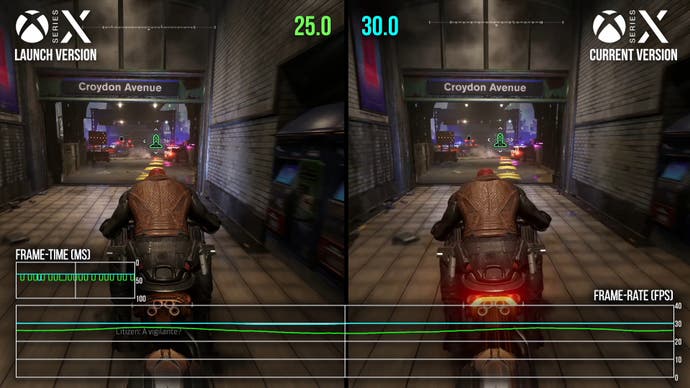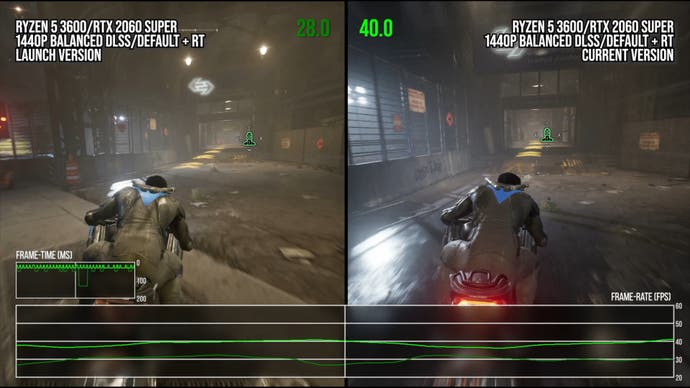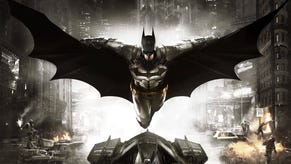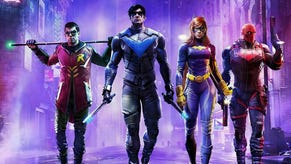Gotham Knights is fixed - so we've re-reviewed every version of the game
Five months on, an altogether more positive DF tech analysis.
Gotham Knights had some definite issues when it launched last year. A mixture of lighting problems, odd technical hangups, and strange design choices undermined what should have been an attractive game. This was made all the worse from comparisons to its 2015 predecessor, Batman: Arkham Knight, which was in many ways a more visually accomplished title. But the game's key issue came down to performance, running at a highly unsteady 30fps, with harsh frame-rate drops, stutters, and frame-time fluctuations. The game felt rough and jerky as a result, particularly when travelling through the open world. For a current-gen only title pushing unambitious visuals, this level of performance bordered on unforgivable.
It's not often that we produce re-reviews of games on Digital Foundry - the constraints on our time are just too heavy - and this does mean that sometimes welcome technical improvements lack the attention they deserve. We're going to make an exception for Gotham Knights though, because while our coverage was harsh but fair at the time, five months of patches have radically transformed the game - for the better.
Going back to the initial release, it had three key problems. Firstly, the game was frequently beset by conventional frame-rate issues. Gotham Knights tended to buckle when traversing through the open world, with harsh drops often characterised by stutters as high as 83 milliseconds or so. Performance profiling on the PC version revealed that most of these problems were CPU related though the game could exhibit more stable, extended frame-rate dips where it seemed GPU-bound.
Secondly, Gotham Knights had issues with frame delivery. You'd see a mix of 16, 33, and 50 millisecond frames in general gameplay even when the overall frame-rate was pegged to 30fps. The game never really felt truly stable, with bizarre frame-time fluctuations that came as a byproduct of the studios' chosen frame-rate capping method. Finally, the game would occasionally chug with no clear driving factor, like in the train terminals where performance could inexplicably drop into the low 20s, frame-rate wise. Gotham Knights had some issues with bugs and general stability, and that extended to some baffling problems in select areas at times.
These issues made Gotham Knights' 30fps frame-rate target feel messy and sort of broken. It was one of the worst-performing major titles on current-gen machines, with obnoxious performance woes that had a constant impact on playability and fluidity. However, after a concerted patching effort, the situation has been dramatically improved. Looking at the PS5 release, we're getting close to a locked 30fps. Interior scenes play back without any issues whatsoever, absent of the frame-time troubles we observed at launch. The choppy, inconsistent motion has been completely solved here - it's a huge upgrade.
Open-world traversal, where the launch release suffered most, is also very stable. Long stretches run at a perfect 30fps, even when speeding through Gotham City on the Batcycle. I can't say it's completely perfect - one-off dropped frames can pop up, though not more often than every few minutes or so. For all practical purposes, open world gameplay just hugs that 30fps update. The opening bike chase, which is possibly the most consistently demanding scene in the entire game, provides a helpful illustration. The updated PS5 code is almost a flat line here, with just a handful of dropped frames through the entire sequence, while the launch version goes on a bit of a frame-time rollercoaster ride. There are extended dips, sharp stutters, and plenty of 16 millisecond frames sprinkled in for good measure on that original code. The new version brings a night-and-day improvement, and is ultimately a much more enjoyable experience.

The Xbox consoles follow much the same pattern. Interior scenes run at a locked 30fps, with outdoor scenes not entirely perfect but much improved. Both Series S and X feel much better to play than in their initial forms. Unfortunately, they do lag behind the PS5 release here, despite the enhancements over the launch code - with slightly more noticeable performance drops in traversal along with odd animation issues in certain cutscenes. Essentially, object and camera animation run with inconsistent travel at times, which is particularly noticeable during broader movements. Frame-rates are locked to 30fps here, but the actual underlying animation looks as if it is not being interpolated correctly. Curiously, this issue doesn't seem to be present in the launch Xbox versions - or on the PS5 as of today. Hopefully this can be fixed, as it is distracting.
So the consoles are much more consistent performers as of recent updates - so what exactly has changed? Patch notes mention the inclusion of dynamic resolution scaling, though the impact of that is limited. The launch versions came in at a locked 2160p on Series X and PS5, and 1440p on Series S. The maximum resolutions are the same as of the update release, though mostly the game continues to come in at those top-end figures. PS5 and Series S both clocked at the same resolutions as before in every shot I tested, while Series X reached a low of 2016p at worst.
I also couldn't find any downgrades to the game's ray tracing, which is present on PS5 and Series X. RT still makes significant use of screen-space information when available, and distant geometry is often absent from the BVH structure, but the resolution of the RT is relatively high. What seems to have happened with Gotham Knights then is genuine optimisation, particularly on the CPU side.

This is most demonstrable on PC, where we can unlock frame-rates and let the game run riot. At launch, the PC build was CPU-bound, just like consoles, and was mostly limited by the performance of a single CPU thread during open-world gameplay. Gotham Knights also suffered from serious shader compilation issues during the game's early sections. As of the latest patch, the game's performance woes have been largely alleviated and at times there are massive improvements to frame-rates. Shader compilation is no longer an issue, as the game pre-compiles shaders during its first boot, and frame-rates are much improved during CPU-bound sequences. We're still short of 60fps during a lot of the open-world traversal, but frame-rate averages have improved by 10-15fps or so since the initial release.
I played through roughly the first hour on my high-end PC on maximum settings at 4K with DLSS 2 quality mode and the game is in pretty reasonable shape there. We're still CPU-limited to some degree during select frames when targeting 60fps, but the game is mostly a solid 60 here. Lowering the view detail and environmental density settings can help though and uncapped performance tends to average around 100fps in the open world. I'm not completely happy with the way the game is scaling on PC - a consistent 60fps is out of reach for most mainstream systems, which feels a bit gratuitous given how this game looks. Plus, the cutscene animation issues do return here, at least at 60fps, with jittery movement just like on the Xbox Series consoles. However, as long as you have a fast CPU with high clockspeeds, Gotham Knights can mostly deliver a good experience here, with much improved fluidity over the consoles.
After some further reflection, I think Gotham Knights' visuals - while largely unchanged in this version - do deserve considerable praise. Ultimately, Gotham Knights is best understood as a game of two halves, visually speaking. The first half is the game's mission environments. Basically any time you start a major mission, Gotham Knights loads into a space that features pretty solid visuals. Lighting is a particular standout in these environments. Each of the game's interior spaces features very attractive ambient lighting with excellent GI, and well-placed light sources. Technically speaking it's par for the course with big-budget Unreal Engine 4 titles, but it often looks excellent. There's plenty of fog, volumetrics, and smoke in these areas as well, which gives them a sort of lived-in quality.

Assets also impress here. Again, this isn't generation-defining stuff but geometric density and texture resolution are both suitably high. The artwork here holds up well at close range and the game itself has a lot of asset variety, with key story areas showcasing very different interior stylings. If you just evaluated Gotham Knights on the interiors alone, it would seem like a very good-looking game. A lot of effort has clearly been expended to make these spaces look unique and attractive, with capable rendering technology combined with carefully-crafted artwork and visual design.
The other half of the game is set in Gotham City itself, and this is really where the game's visual issues become apparent. A lot of my concerns here really come down to lighting quality. Gotham Knights' open world does have a lot of light sources but ambient lighting basically seems non-existent. Each light is surrounded by a ring of very dark colour, as if each light has no contribution to overall scene lighting. The overall impression is that GI is largely missing in the open world environment. It's hard to escape the feeling that Gotham City's lighting is broken, with stark, contrasty lighting that lacks the sort of information needed to build a convincing lighting setup. It's especially curious because there is an attempt to showcase indirect lighting properties elsewhere, as you see light scatter through the game's atmospheric fog. The game's 'hero lighting', an omnipresent highlight that follows the player character, also looks odd juxtaposed against urban areas.
Gotham is also home to some of the more bland gameplay elements in Gotham Knights. A lot of the open-world gameplay consists of scanning for and defeating specific enemy types, which is a tedious sort of hide-and-seek exercise, given how sparse the criminal groups are. The batcycle also feels ponderously slow, taking too long to traverse the game's broad city streets.
It really feels like the open world gameplay was designed around a different set of technical constraints, with a streaming system that would permit much faster traversal, a denser placement of in-game NPCs, and proper large-scale world events. You get the sense that there's some underlying hangup here - perhaps the game assets were designed with a lot of unique elements that made them difficult to stream, for instance, or possibly UE4 itself is throwing up some obstacles.
Gotham Knights still has obvious visual issues that will probably never be property addressed, but performance has been profoundly improved since the launch release. The PC build is way ahead of its initial showing with much better typical frame-rates, and the consoles manage a much closer 30fps lock as well. PS5 in particular is just about where it should be, with an almost unblemished 30fps update in my testing.
The game's CPU limitations mean that a 60fps update would be difficult to implement for console players, but the game feels totally reasonable now that gameplay presents in a relatively consistent way. If you're itching for an open-world superhero fix, Gotham Knights now offers a perfectly decent experience - and it's great to see that pretty much every critique we had of the game's technical performance has now been addressed.






.jpg?width=291&height=164&fit=crop&quality=80&format=jpg&auto=webp)




